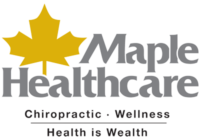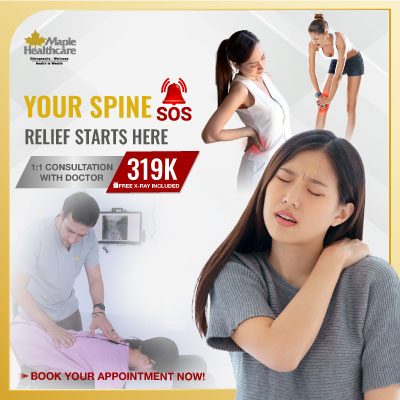Scoliosis: Diagnosis, Treatment, and Care at Maple Healthcare
Scoliosis negatively affects the spine, unfortunately causing it to curve out sideways. The onset of this particular condition typically occurs during one's formative or teenage years. Other individuals may develop it at any point throughout their lifespan. Some people show visible signs, while others feel pain or stiffness without noticing the curve.
Left without appropriate treatment, the condition can deteriorate over the course of time. Severe cases may affect breathing or movement. Doctors use physical exams and imaging to find the problem and then recommend a suitable plan. Many patients improve with the right care. Chiropractors, therapists, and doctors all play a role, each bringing a different tool to manage the curve.
How Scoliosis Starts and What to Do About It
Scoliosis is an uncomfortable condition where the spine curves across to the side. On X-rays, it may look like a contorted spine manifesting a strange “S” figure, or otherwise a “C” shape. A small curve might not cause any issues, but a larger one can affect posture and movement. Some people are born with this curve, which may occur somewhere in the upper or lower back. Others may gradually develop this debilitating condition over a period of time. Most cases show up during growth spurts in teenage years. Doctors diagnose this condition through physical exams and imaging tools.
Scoliosis and kyphosis are different. Kyphosis curves forward, while scoliosis bends sideways. Some people may have both. Treatment depends on the severity, with mild cases potentially needing only monitoring. More advanced cases might need therapy, braces, or even surgery.
Exercises and stretches can help. These movements improve strength and posture, supporting other treatments. A healthcare provider can guide which stretches work best. Managing the curve early can prevent long-term issues.
Causes and Types of Scoliosis
Scoliosis develops for different reasons, depending on age, health, and other conditions. In most cases, the cause remains unknown. Doctors call this version of the condition “idiopathic.” It usually appears in children or teens, often during growth spurts. Doctors believe genes play a part—if one family member has it, others may be more likely to develop it too.
Some children are born with a curved spine. This form of the condition is “congenital.” It happens when the spine does not form correctly during early pregnancy. The bones may be incomplete, misshapen, or fused. As the child grows, the curve often becomes more visible, so early treatment helps guide the spine as it develops.
There are several health conditions tied to neuromuscular scoliosis. These generally include the likes of cerebral palsy, with muscular dystrophy and spina bifida also implicated. When muscles cannot support the spine, the bones shift – the curve may grow quickly and often needs close care. Physical therapy and bracing can help, and in some cases, a doctor should perform surgery.
In adults, this condition can develop later in life. Medical practitioners call this form “degenerative.” It comes from aging, wear and tear, or arthritis. Discs and joints lose shape and support. The spine may slowly curve, leading to back pain, stiffness, or nerve issues. Past injuries can also lead to this variety of the disorder.
There is also “functional” scoliosis. Here, there is no damage to the spine itself. Instead, problems such as muscle spasms, poor posture, or uneven legs create a curve. After an expert has determined the root cause, the spine can often return to its normal shape.
Each form of this condition behaves differently. Some deteriorate quickly, while others remain stable for years, so doctors must identify the type before they choose a treatment.
Symptoms of Scoliosis
People with this condition see noticeable posture changes. One shoulder often rises higher than the other, while in others, the waist appears asymmetrical. A hip might protrude more on one side, as clothes hang unevenly on the body. Patients observe these changes during rapid development periods.
Back pain can occur in some cases. Children may not feel pain, but adults often do. The muscles exert extra effort to maintain upright posture, which can cause fatigue or discomfort. In severe cases, the disorder may affect breathing, while a sizable curve can reduce space in the chest.
Scoliosis and kyphosis may appear together. That can make posture problems worse. A forward curve and a sideways curve place extra strain on the spine.
Not everyone shows symptoms. Some cases are only found during a school screening or routine checkup. Doctors look for these visible signs and confirm the condition with imaging. Noticing symptoms early gives a better chance to control the curve.
Diagnosing Scoliosis
Doctors start with a physical check, looking for uneven shoulders or hips. The person may bend forward to show the curve. This test helps reveal any spinal tilt. Doctors then measure the angle of the curve.
Physicians request radiographic imaging when they detect disorder indicators, allowing complete spinal contour visualization. X-rays also help track changes over time. In some cases, doctors may use MRI or CT scans, which check for nerve issues or spine defects.
Early diagnosis matters as catching the problem before the curve gets worse helps significantly. Schools often run programs to check children. Parents can also spot signs during growth spurts.
Combined scoliosis and kyphosis create diagnostic challenges for physicians. A doctor must separate the two. Only proper tests will show which condition is present.
Diagnosis also includes questions about family history. The disease does run in families, so knowing family medical history can help doctors plan the next treatment steps.
Treatment Options for Scoliosis
Doctors choose treatment based on curve size, age, and symptoms. Regular monitoring suffices for mild disease manifestations. These visits track changes during growth. If the curve stays the same, doctors will not recommend additional steps. Parents play a key role in watching for new signs.
Moderate forms may require a back brace. The brace fits snugly under clothing. This approach yields optimal results during spinal growth phases. A good fit is important for success, and while braces do not reverse the curve, they stop it from worsening.
Severe cases may need surgery – surgeons use rods and screws to straighten the spine. They also use bone grafts to fuse parts of the spine. This option helps when pain or breathing problems occur.
Physical therapy can support any treatment plan. It builds strength and improves movement. Specific exercises and stretches reduce stiffness and help the spine stay balanced.
Doctors take different approaches in treating scoliosis and kyphosis, using imaging to find the right match. Every plan is unique, depending heavily on the cause, type, and how the curve affects daily life.
Can a Chiropractor Help with Scoliosis?
Spine specialists adjust vertebral alignment to improve function and stability, aiming to reduce pain and improve mobility. For people with this condition, they offer muscle tension and stiffness relief, with adjustments easing pressure on joints and nerves.
Chiropractic care does not correct the curve, but it does help manage how the body feels and moves. Many people report better posture and less daily discomfort. These practitioners provide guidance about postural habits, sleeping positions, and everyday activities. These tips support long-term wellness.
Chiropractors often join forces with physical therapists. This teamwork offers stronger results. Each expert brings a different skill. The patient receives a plan tailored to their needs.
- Exercises and stretches play a key part in care. Chiropractors may teach these movements. They improve balance, increase flexibility, and ease tight muscles helping the body adapt over time.
- Remember, scoliosis and kyphosis need clear diagnosis. A chiropractor looks at imaging, symptoms, and patient history to choose the safest methods for each case.
Chiropractic care is safe and non-invasive. It fits well into many broader treatment plans. With the right hands, the spine feels freer and stronger.
Why Choose the Pain Management Center at Maple Healthcare for Scoliosis?
Maple Healthcare in Ho Chi Minh City offers expert care for spine issues. Their team understands how scoliosis affects your daily life. They treat each person with care and attention, while the clinic blends modern tools with natural therapies.
Doctors and therapists work together to build custom plans for each patient. Treatment protocols often incorporate spinal adjustments, therapeutic exercises, and structured movement therapies. The goal is to ease pain, improve strength, and help the body move well.
Maple clinic’s staff listens to patients, explaining every step clearly. Patients feel safe and involved in their own progress. Maple Healthcare creates a space where healing feels personal.
Scoliosis and kyphosis both receive careful attention here. The team knows how to tell them apart and treat them right. They use full exams and clear images to understand each curve.
Scoliosis exercises and stretches are part of many plans. Therapists teach safe ways to move and build support, helping the spine stay strong over time.
Maple Healthcare stands out for its results and kindness. Patients leave feeling stronger and more confident. The clinic brings skill, heart, and hope to every visit. If you have questions that need answering, please leave information in the form below or contact us directly at: FANPAGE MAPLEHEALTHCARE
Related articles:
MAPLE INTERNATIONAL CO., LTD
Phone: 0705 100 100
Tax code: 0311948301
Date Range: 21 - 08 - 2012
Issued: Department of Planning and Investment of Ho Chi Minh City

















